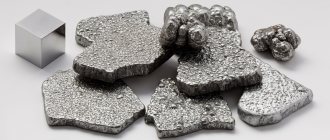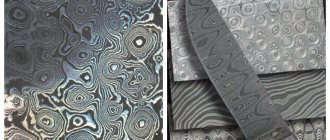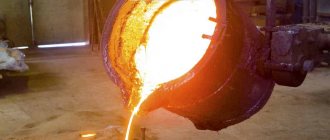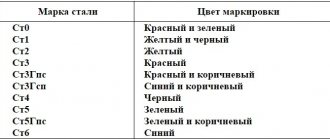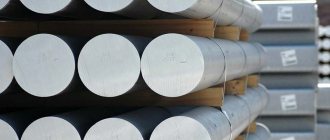Before talking about the melting point of stainless steel, it is worth noting that this physical characteristic is important for foundries, welders, and manufacturers of branded stainless steel.
When metalworking, other concepts are used, for example, the point of eutectic (equilibrium of the liquid and solid phases), the point of plasticity (t, at which the alloy becomes soft and pliable).
General description of the process
To understand at what temperature steel melts, you need to look at this process in more detail. Melting occurs when heated. The material can be heated both from the outside and from the inside. External heating is carried out in thermal furnaces. Resistive heating is used to melt the alloy from the inside. The principle of resistive heating is the electrical resistance that any material has.
Regardless of the type of thermal effect, the same changes occur in materials. Due to heating, thermal vibrations of molecules are enhanced, which leads to structural defects in the lattice. Such changes contribute to the rupture of interatomic bonds, as a result of which the alloy passes into a liquid state.
Stainless steel grades
First of all, this is EI417 or 20Х23Н18 according to GOST 5632–61. An analogue of Western European and American manufacturers is the well-known AISI 310. Austenitic steel, products from which are in demand for work in environments with temperatures reaching 1000 °C.
20Х25Н20С2, also known as EI283, is an austenitic alloy resistant to temperatures of 1200 o C and above.
Low carbon alloys with a chromium content of 4 to 20% are used to produce stainless steel sheets. Heat-resistant stainless steel is available in cold-rolled and hot-rolled, thick-sheet and thin-sheet assortments.
Alloy types
Depending on the intensity of heating required for the transition of a metal from one state to another, alloys are divided into several types.
Low fusible. They can be processed even without special equipment. The melting point of steel in degrees Celsius is 600. Low-melting metals include lead, tin and zinc.
Mercury deserves special attention because it can turn into a liquid state at -39°C.
Medium melting. The melting point of steel is in the range of 600°C-1600°C. This category includes aluminum, copper, tin, some types of stainless steel and various alloys with a small chromium content. Medium-melting compounds are most widespread in industry and in everyday life.
Refractory. Compounds included in this category are capable of transitioning from solid to liquid when heated above 1600°C. These are highly alloyed metals, which include tungsten, titanium and chromium. Thanks to these additives, the metal acquires increased strength, resistance to corrosion and chemical influences. In particular, stainless steel is a refractory alloy.
Alkali metals melt at the lowest temperatures. Accordingly, for non-alkali metals to transition into the liquid state, the temperature range increases significantly.
Boiling degree
When heating a material, it is important not to reach its boiling point, at which point it goes from a liquid state to a gaseous state. Therefore, the boiling point is an equally important technological indicator.
The boiling point is typically twice the degree at which materials melt and is determined at normal atmospheric pressure. As the pressure increases, the heating intensity also increases. As the pressure decreases, the readings decrease.
Features of Carbon Steel
Carbon compounds are the main type of products produced at metallurgical plants. In addition to iron, they also contain carbon. Its concentration should not exceed 2.14%. They contain a small amount of impurities and alloying components in the form of manganese, silicon and magnesium. Such additives can improve their physical and chemical properties.
Depending on the carbon concentration, carbon compounds are divided into the following types:
- low-carbon (carbon content does not exceed 0.29%);
- medium carbon (up to 0.6%);
- high carbon (more than 0.6%).
Carbon compounds are used in various industrial sectors. Depending on the scope of application, alloying components are added to them to achieve specific properties, including heat resistance, corrosion resistance, etc. According to these criteria, they are divided into the following categories:
Influence of elemental composition on the liquidus point of different grades of stainless steel
Stainless steel grades generally include steel (an alloy of carbon and iron) with a high (at least 8% by weight) degree of alloying with other chemical elements, which, according to its performance characteristics, is included in one of the following groups:
- corrosion-resistant steels – resistant to chemical, electrochemical, intergranular and other types of corrosion;
- heat-resistant steels (also known as scale-resistant steels) – in an unloaded/lightly loaded state, they are resistant to chemical destruction in a gas environment at ambient temperatures exceeding 550°C;
- heat-resistant steels – in a high-temperature environment and in a loaded state, they have the specified mechanical stability and heat resistance.
Note that the domestic marking of stainless steel is a number-letter combination that allows you to determine the content of all the main alloying components in it: for example, steel 09Х15Н8У1 has a mass fraction of carbon not higher than 0.09%, chromium - about 15%, nickel - about 8% , aluminum - about 1% (the structure and marking elements are described in detail in GOST 5632-72).
Components such as phosphorus, sulfur, silicon, manganese and carbon, to one degree or another, unambiguously lower the liquidus point throughout the range of their concentrations relative to pure iron (Tm
1540°C), while for the remaining components a V-shaped characteristic is more often observed (maximum decrease in the liquidus point with increasing concentration to the threshold, after which an increase is observed again): for example, for chromium the threshold
22%, for tungsten – 4.4%.
Overall rating of the article:
Published:
2020.01.02
_ _ _ _ _ _ _ _ _ _ _ _ _ _ _ _ _ _ _ _ _ _ _ _ _ _ _ _ _ _ _ _ _ _ _ _ _ _ _ _ _ _ _ _ _ _ _ _ _ _ _ _ _ _ _ _ _ _ _ _ _ _ _ _ _ _ _ _ _ _ _ _ _ _ _ _ _ _ _ _ _ _ _ _ _ _ _ _ _ _ _ _ _ _ _ _ _ _ _ _ _ _ _ _ _ _ _ _ _ _ _ _ _ _ _ _ _ _ _ _ _ _ _ _ _ _ _ _ _ _ _ _ _ _ _ _ _ _ _ _ _ _ _ _ _ _ _ _ _ _ _ _ _ _ _ _ _ _ _ _ _ _ _ _ _ _ _ _ _ _ _ _ _ _ _ _ _ _ _ _ _ _ _ _ _ _ _ _ _ _ _ _ _ _ _ _ _ _ _ _ _ _ _ _ _ _ _ _ _ _ _ _ _ _ _ _ _ _ _ _ _ _ _ _ _ _ _ _ _ _ _ _ _ _ _ _ _ _ _ _ _ _ _ _ _ _ _ _ _ _ _ _ _ _ _ _ _ _ _ _ _ _ _ _ _ _ _ _ _ _ _ _ _ _ _ _ _ _ _
Melting point table
To find out what temperature is needed to melt metals, a table of increasing temperature indicators will help.
| Element or connection | Required temperature conditions |
| Lithium | +18°С |
| Potassium | +63.6°С |
| Indium | +156.6°С |
| Tin | +232°С |
| Thallium | +304°С |
| Cadmium | +321°С |
| Lead | +327°С |
| Zinc | +420°С |
Melting table for medium-melting metals and alloys.
| Element or alloy | Temperature |
| Magnesium | +650°С |
| Aluminum | +660°С |
| Barium | +727°С |
| Silver | +960°С |
| Gold | +1063°С |
| Manganese | +1246°С |
| Copper | +1083°С |
| Nickel | +1455°С |
| Cobalt | +1495°С |
| Iron | +1539°С |
| Durali | +650°С |
| Brass | +950…1050°С |
| Cast iron | +1100…1300°С |
| Carbon steels | +1300…1500°С |
| Nichrome | +1400°С |
Melting table for refractory metals and alloys.
| Item name | Temperature |
| Titanium | +1680°С |
| Platinum | +1769.3°С |
| Chromium | +1907°С |
| Zirconium | +1855°С |
| Vanadium | +1910°С |
| Iridium | +2447°С |
| Molybdenum | +2623°С |
| Tantalum | +3017°С |
| Tungsten | +3420°С |
What is melting point
Each metal has unique properties, and this list includes its melting point. When melting, the metal changes from one state to another, namely, from solid to liquid. To fuse a metal, you need to bring heat closer to it and heat it to the required temperature - this process is called the melting point. At the moment when the temperature reaches the desired level, it can still remain in a solid state. If you continue the impact, the metal or alloy will begin to melt.
Melting and boiling are not the same thing. The point at which a substance transitions from solid to liquid is often referred to as the melting point of the metal. In the molten state, the molecules do not have a specific arrangement, but attraction holds them close together; in liquid form, the crystalline body leaves volume, but the shape is lost.
During boiling, the volume is lost, the molecules interact very weakly with each other, move chaotically in different directions, and separate from the surface. Boiling point is the process by which the pressure of metal vapor is equal to the pressure of the external environment.
In order to simplify the difference between critical heating points, we have prepared a simple table for you:
| Property | Melting temperature | Boiling temperature |
| Physical state | The alloy transforms into a melt, the crystalline structure is destroyed, and granularity passes through | Transforms into a gas state, some molecules can fly away outside the melt |
| Phase transition | Equilibrium between solid and liquid | Pressure equilibrium between metal vapor and air |
| Influence of external pressure | No changes | There are changes, the temperature decreases with discharge |
At what temperature does it melt?
Metal elements, whatever they are, melt almost one to one. This process occurs when heated. It can be both external and internal. The first takes place in a furnace, and for the second, resistive heating is used, passing electricity or induction heating. The impact is almost the same. When heated, the amplitude of molecular vibrations increases. Structural lattice defects are formed, which are accompanied by the breaking of interatomic bonds. The process of lattice destruction and the accumulation of such defects means melting.
Different substances have different melting points. Theoretically, metals are divided into:
- Low-melting - temperatures up to 600 degrees Celsius are sufficient to obtain a liquid substance.
- Medium melting - requires a temperature of 600 to 1600 ⁰C.
- Refractory are metals that require temperatures above 1600 ⁰C to melt.
Melting iron
The melting point of iron is quite high. A technically pure element requires a temperature of +1539 °C. This substance contains an impurity - sulfur, and it can only be extracted in liquid form.
Without impurities, pure material can be obtained by electrolysis of metal salts.
Melting cast iron
Cast iron is the best metal for smelting. The high fluidity rate and low shrinkage rate make it possible to use it more effectively during casting. Next, consider the boiling point of cast iron in degrees Celsius:
- Gray - the temperature can reach 1260 degrees. When pouring into molds, the temperature can rise to 1400.
- White - the temperature reaches 1350 degrees. It is poured into molds at 1450.
Melting steel
Steel is an alloy of iron mixed with carbon. Its main benefit is strength, since this substance is capable of maintaining its volume and shape for a long time. This is due to the fact that the particles are in an equilibrium position. Thus, the forces of attraction and repulsion between particles are equal.
Melting aluminum and copper
The melting point of aluminum is 660 degrees, which means that it can be melted at home.
Pure copper is 1083 degrees, and for copper alloys it ranges from 930 to 1140 degrees.
What does melting temperature depend on?
For different substances, the temperature at which the structure is completely reconstructed to the liquid state is different. If we take into account metals and alloys, then it is worth noting the following points:
- Metals are not often found in their pure form. The temperature directly depends on its composition. As an example, we will indicate tin, to which other substances (for example, silver) can be added. Impurities make the material more or less resistant to heat.
- There are alloys that, due to their chemical composition, can transform into a liquid state at temperatures above one hundred and fifty degrees. There are also alloys that can “hold” when heated to three thousand degrees and above. Taking into account the fact that when the crystal lattice changes, the physical and mechanical qualities change, and operating conditions can be determined by the heating temperature. It is worth noting that the melting point of a metal is an important property of a substance. An example of this is aviation equipment.
Heat treatment, in most cases, almost does not change the resistance to heat. The only sure way to increase resistance to heat is to make changes to the chemical composition; this is why steel is alloyed.
Processing steel to obtain special properties
To give a material certain properties or change them, alloying elements and various types of processing are used.
Some metals act as alloying elements. They can be chromium, aluminum, nickel, molybdenum and others. In this way, certain electrical, magnetic or mechanical properties, as well as corrosion resistance, are achieved. Thus, stainless steel is obtained if it has been alloyed with chromium.
The properties of steel change by processing:
- thermomechanical (forging, rolling);
- thermal (annealing, hardening);
- chemical-thermal (nitriding, cementation).
Heat treatment is based on the property of polymorphism - when heated and cooled, the crystal lattice is capable of changing its structure. This property is characteristic of the basis of steel - iron, and therefore is inherent in it.
Different types of elements that may be present in steel
Carbon . As the percentage of this element in steel increases, its strength and hardness increases. But there are losses in plasticity.
Sulfur . This impurity is harmful because, together with iron, it forms iron sulfide. Because of it, cracks appear in the material as a result of the loss of bonds between grains during processing at high temperatures and under pressure. The presence of sulfur also negatively affects the strength of steel, its ductility, wear resistance, and corrosion resistance.
Ferrite . This is iron, which has a body-centered crystal lattice. It is characteristic that alloys containing it are soft and have a plastic microstructure.
Phosphorus . If sulfur reduces strength at high temperatures, phosphorus makes steel brittle at low temperatures. Nevertheless, there is a group of steels in which the content of this seemingly harmful element is increased. Products made from this metal are very easy to cut.
Cementite , also known as iron carbide. Its effect is opposite to that of ferrite. The steel becomes hard and brittle.


